How Long Does it Take to Sail Around the World?
My big dream is to one day sail the world seas with my wife. But I was unsure how long it actually takes. So I got into it and wrote this article.
How long does it take to sail around the world? Sailing around the world takes between 3 to 5 years. It can be done incredibly fast: the world record is 40 days on a trimaran. On average, most people that take the time to do some sightseeing need about 3.5 years.
As you can see, there's no set amount of days. How long you'll actually take greatly depends on all kinds of factors. You can take up to 10 years if you want. Perhaps the most important decision is whether you turn left or right at the beginning of your sailing trip. It's true - read on to find out why.
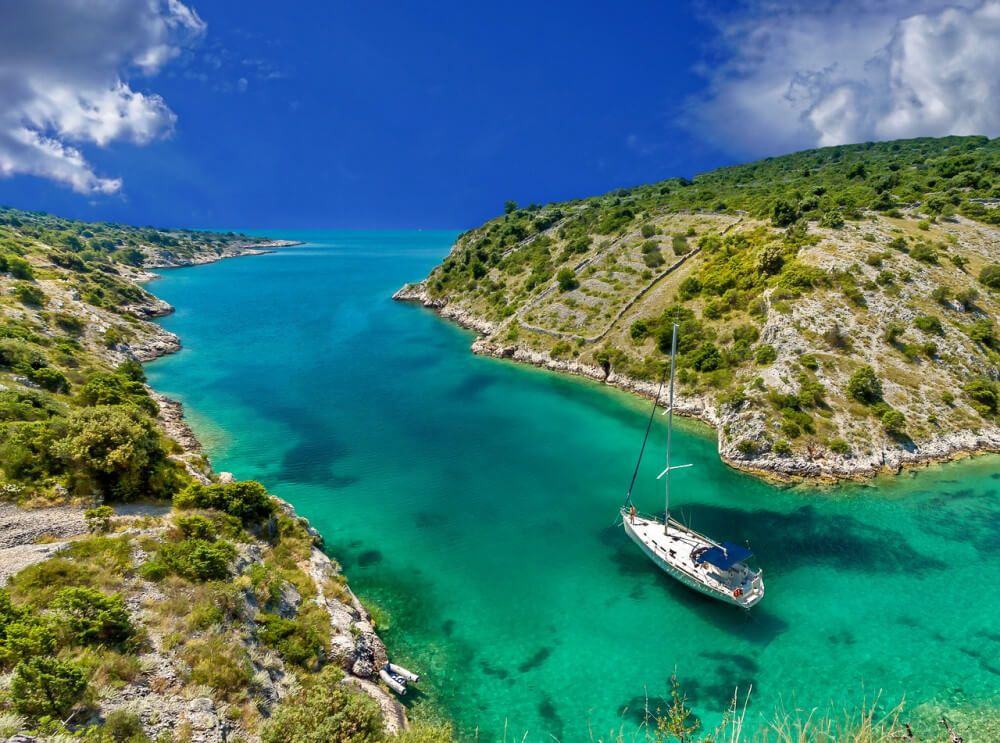
How To Estimate the Duration
There are lots of different factors that make up the length of a sailing trip around the world. To get a more precise estimate, let's start with the different styles of planning and sailing. I belief there are three ways to go at it:
- Non stop - takes roughly 100 days - no time to do anything but sailing at 20 knots
- Express - takes roughly 1 to 2 years - fast paced sailing for the most part, with short, regular breaks
- Recreational - takes anywhere from 3 to 10 years - smooth and comfortable sailing with long breaks
Non stop sailing means literally planning on taking the least amount of stops necessary. You try and maximize your sea days and only stop for provisioning and emergencies. No sight-seeing. To me, this only makes sense if you're in a race (with someone else or yourself) and own a fast ship.
Express sailing is popular among young people that plan on doing other things with their life after their trip. These kind of trips take 2 years on average. This style of planning allows you 1 - 2 sit days for each sea day, meaning you have about 1 day to dock, provision, make any repairs if needed - and then you get 1 day of to check out beautiful Tahiti.
Recreational fast pace allows for 5 sit days for each sea day. This gives you a fair amount of time to explore the region around the port, but it doesn't allow for deeper exploration or getting to know the culture of the area or country you're staying in. Expect to complete your circumnavigation in 3 - 5 years. This pace makes a lot of sense to me, as it allows you to stay put if the hurricane season sets in.
Recreational slow pace allows for 10 sit days for each sea day. This gives you plenty of time for exploration, getting to know the culture (and cuisine!) of your location, and staying put for several months on end. Perfect for retirement.
Resources for planning your circumnavigation
Other factors that affect the length
Your choice of style depends on multiple factors that all correlate. Besides your choice of pace, the most important factors that determine travel time are:
- objective
- money - this determines how much time you have, but also how fast your ship is
- route
- planning - you need to take any hurricane seasons into account
- hull speed
- boat size - a small boat needs to stop more often for provisioning. Also, large boats tend to be more stable, allowing you to sail in heavier weather
- (navigational) skill
- preparation (and luck) - breakdowns and repairs add a lot of time to the journey
Want to know how to calculate the hull speed of any boat? It's easy to do, and I've written an article about it. Read it here (new tab).
Your objective plays a major part in all choices
If your main objective is to see the world, and learn as much as you can on different places and people, you might choose to avoid the capes altogether and get some more time for exploring the coastal areas.
If your objective is to do a complete circumnavigation, you must sail around all three capes. You've just added 3,000 nautical miles (NM) to your travel distance.
If safety is very important to you, you might want to avoid the Indian Ocean. But this means you can't take the Suez canal and need to do a large detour around Cape of Good Hope.
If your objective is to just take it easy, you could end up staying on shore for a year in New Zealand - you wouldn't be the first to do so.
I was surprised at how cheaply you can buy & own a sailboat nowadays. I've compared thousands of sailboat prices and all the recurring costs in my article Average Cost of Buying & Owning a Sailboat (With 4 Examples) (new tab).
How Fast Can It Be Done?
If we take a look at the numbers above I immediately notice that they are all over the place. An amateur takes 30 times longer to cover less distance than the world record holder. How come?
It takes the average person about 3.5 years (around 1,280 days) to go around. How fast can it be done by a pro?
- World record: 40 days - by Francis Joyon and crew of 6 on Trimaran IDEC 3 (100 ft)
- Single-handed world record: 42 days - by François Gabart on Trimaran Macif (100 ft)
- Fastest monohull: 74 days - by Armel Le Cléac'h on monohull Banque Populaire VIII (60 ft)
All of these people have one thing in common: they chose to sail eastward.
In the water, conditions affect the outcome a lot - way more than on any road. The route you choose doesn't just determine distance, but also the strength of the winds, the current, your hurricane planning, and so on. Precisely because of these factors, the westward route is more demanding. The fastest monohull to go around westward did it in 122 days. In comparison, the monohull world record for the eastward route is just 74 days.
Possible Circumnavigation Routes
The route you choose affects your travel distance a lot, but also the current and strength of wind.
Sailing around the world means to start from point A, sailing into one direction until you've returned at point A. To do this, we can go either eastward or westward. This decision matters.
The second decision is whether or not to sail around the capes. Most people don't bother, since the best sailing is in the Mediterranean, Caribbean, and South Pacific. They pass the Panama and Suez Canal.
If you do choose to go around all three major capes, it can increase your distance by about 15%, which is a lot in terms of time. Competitive sailors always go around the capes, which adds a lot of distance. This is the historical route and also the longest.
The shorter route (which makes use of the canals) is also called the trade wind route. I've previously written a detailed article on this route, and why they are called trade winds. I think it's a great article if you're interested in marine navigation and history. You should definitely check it out by clicking here (new tab).
The most common eastward sailing route is:
- Mediterranean Sea: Gibraltar - through Suez Canal
- Indian Ocean: from Red Sea - Maldives - Australia
- South Pacific: from Sydney - Tahiti
- South Pacific: from the Tahiti - Panama - Caribbean
- North Atlantic: from the Caribbean - Azores - Gibraltar
The most common westward sailing route is:
- North Atlantic: from Gibraltar - Caribbean (Windward Islands)
- South Pacific: from the Caribbean - Panama - Tahiti
- South Pacific: from Tahiti - Sydney
- Indian Ocean: from Australia - Maldives - Red Sea
- Mediterranean Sea: through Suez Canal - Gibraltar
If you wish to avoid the Indian Ocean, you can instead go around Cape of Good Hope, via the north of Madagascar.
The capes and their alternatives are:
- Africa's Cape of Good Hope - Suez
- South America's Cape Horn - Panama
- Australia's Cape Leeuwin - Arafura Sea
The Arctic waters of the Southern route around the capes is said to be a bit dull.
These two maps perfectly show the different routes:
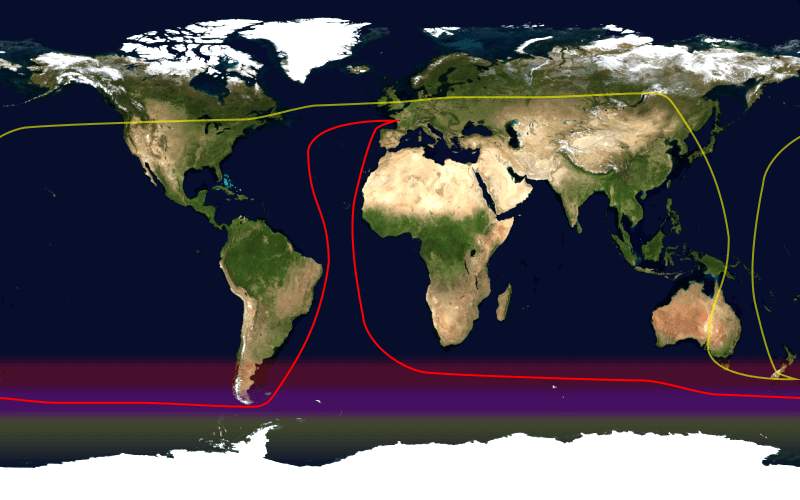
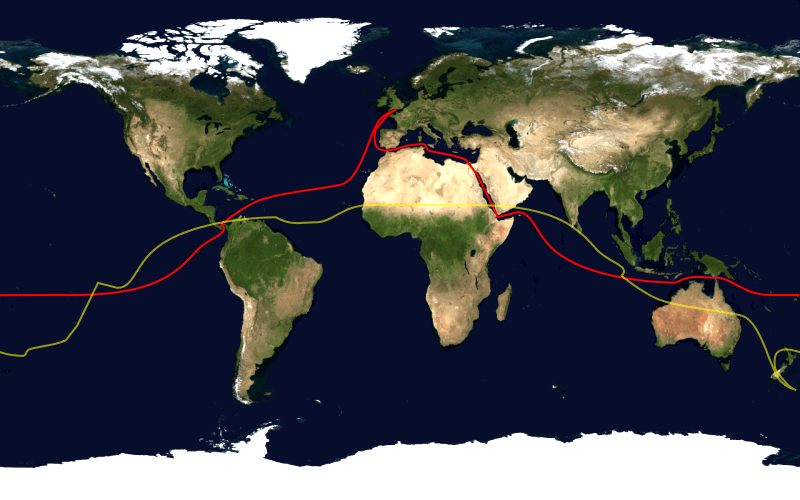
The distances for the different routes:
- Circumnavigation around all three capes: roughly 27,000 NM
- Circumnavigation, skipping all three capes: roughly 24,000 NM
The difference is roughly 3,000 NM, which easily translates into 2 - 3 extra months of sailing.
The safest route around the world
There are places you'd want to avoid, and one route beats all others.
Read all about dangerous routes
Navigation Equipment
If you're preparing a circumnavigation you want to make sure you have the right navigation gear on board.
Nowadays, you can get a good-quality, accurate compass and chartplotter at a great price. If you want to learn more on how to choose the right equipment, head over to the recommended gear section of this website.
Related Questions
How fast is the average sailboat? Most sailboats cruise at 4-5 knots (9 km/h or 5 mph) for 24 hours a day, allowing them to cover up to 100 nautical miles a day. Larger sailboats of 40 ft (12 m) can cruise at 8 knots (15 km/h or 9 mph), allowing them to cover up to 180 nautical miles a day.
How long does it take to sail across the Atlantic? It takes about 2 weeks to cross under ideal conditions. On average it takes about 3-4 weeks to cross the Atlantic. If you get unlucky, and there's no wind for prolonged periods, it can take you up to a month.
Did you find the answer to your specific question?
👍 24 👎 2


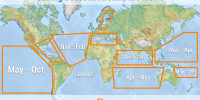


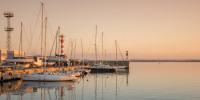
Leave a comment